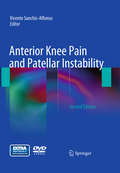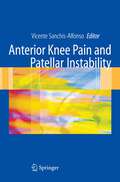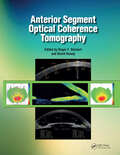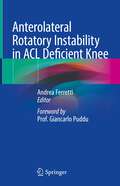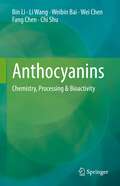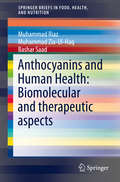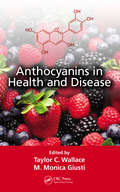- Table View
- List View
The Anterior-Based Muscle-Sparing Approach to Total Hip Arthroplasty
by Jeffrey A. Geller Brian J. McGroryThe minimally invasive, anterior-based muscle-sparing (ABMS) approach to total hip arthroplasty (THA) is utilized worldwide in select locations as an effective surgical technique. As the name suggests, it is completely muscle-sparing and touts the benefits of anterior-based surgery, including a lower dislocation rate, quicker return to baseline function, and lower narcotic use than many other surgical approaches. However, there is a paucity of collected information on the technique and research associated with this technique.This text serves as a compendium of information for those surgeons interested in utilizing this surgical approach as an all-inclusive reference. As an alternative anterior-based approach to the direct anterior surgical approach, some surgeons may find the technique an improved alternative for anterior hip-based surgery. Opening chapters present the history of the anterolateral approach and how to transition to the ABMS approach, including surgical anatomy. ABMS technique with the patient positioned in both the lateral and supine positions are then presented, including associated video segments. Considerations such as implant selection, fixation, and other tips and tricks are shared, along with comparisons to other approaches, patient-reported outcomes, complications and revision surgery techniques, and rehabilitation strategies.For hip surgeons looking to expand their armamentarium of surgical approaches, The Anterior-Based Muscle-Sparing Approach to Total Hip Arthroplasty is a terrific resource.
Anterior Controllable Antedisplacement and Fusion (ACAF): Technique in Spinal Surgery
by China Science Publishing & Media LtdAnterior controllable antedisplacement and fusion (ACAF) is becoming globally regarded as the go-to operative technique for the treatment of ossification of spine ligaments (OSL). Suitable for spinal surgeons and rehabilitation physicians at all levels, this timely reference can help make the surgical intervention of OSL much safer, easier, and more effective. It offers thorough case presentations and discussions on the application of ACAF in the treatment of OSL, ossification of posterior longitudinal ligament (OPLL), ossification of ligamentum flavum (OLF), and spinal stenosis. Describes how to successfully complete an ACAF operation, including surgical instruments, techniques, procedures, and associated key tips. Presents typical clinical cases and covers post-operative rehabilitation of ossification of the posterior longitudinal ligament of cervical spine and cervical spinal canal stenosis. Offers systematic discussions of the clinical and theoretical sources of ACAF technology, and clearly describes the process and details of this technology. Reviews past treatment methods of ACAF-related cervical diseases and the evolution of cervical surgery. Consolidates today's available information on this timely topic into a single, convenient resource.
The Anterior Cruciate Ligament: Reconstruction And Basic Science
by Chadwick ProdromosThe Anterior Cruciate Ligament: Reconstruction and Basic Science, 2nd Edition, by Dr. Chadwick Prodromos, provides the expert guidance you need to effectively select the right procedure and equipment, prevent complications, and improve outcomes for every patient. Written and edited by world leaders in hamstring, allograft, and bone-patellar tendon-bone (BTB) ACL reconstruction, this revised reference is a must-have resource for the full range of anterior cruciate ligament reconstruction techniques, plus fixation devices, rehabilitation, revision ACLR surgery, and much more!Covers the latest clinical and technical information on pain control, genetics and biologics, the use of ultrasound, and much more. Features dozens of new chapters that offer up-to-date information on pain control after ACLR, single vs. double bundle repairs, genetics and collagen type, all-inside techniques, biologics, pediatrics, ACL ganglion cysts, prognosis for ACLR success, allografts vs. autografts, and more. Provides the experience and insight of a "dream team" of ACL experts, including James Andrews on sports medicine, Frank Noyes on HTO and ACLR, and Andrew Amis on the benefits of the older femoral tunnel placement technique.
The Anterior Cruciate Ligament: Reconstruction And Basic Science
by Chadwick Prodromos Charles Brown Freddie H. Fu Anastasios D. Georgoulis Alberto Gobbi Stephen M. Howell Don Johnson Lonnie E. Paulos K. Donald ShelbourneMaster the very latest clinical and technical information on the full range of anterior cruciate ligament reconstruction techniques. Both inside the remarkably user-friendly printed version of this Expert Consult title and on its fully searchable web site, you'll find detailed coverage of hamstring, allograft and bone-tendon-bone (BTB) ACL reconstruction (including single versus double bundle techniques), and hamstring graft harvesting; plus fixation devices, rehabilitation, revision ACLR surgery, and much more!A "dream team" of ACL surgeons provides the advanced guidance you need to overcome the toughest challenges in this area. A comparison of the full range of graft options for ACL reconstruction makes it easier to choose the best approach for each patient. State-of-the-art information on the latest principles and technical considerations helps you avoid complications. ‘How to' principles of post-op rehabilitation and revision ACL surgery optimize patient outcome. Access to the full contents of the book online enables you to consult it from any computer and perform rapid searches. Also available in an upgradeable premium online version including fully searchable text PLUS timely updates.
Anterior Cruciate Ligament Reconstruction: A Practical Surgical Guide
by Rainer Siebold David Dejour Stefano ZaffagniniThis practical and instructional guidebook, written by international experts in anterior cruciate ligament (ACL) reconstruction, covers all challenging aspects of ACL rupture in the acute and chronic setting. It covers the latest, spectacular anatomical findings, treatment of partial ACL tears, various techniques for single- and double-bundle ACL reconstruction, and complex ACL revision surgery. Important surgical steps are clearly described with the help of instructive, high-quality photographs. Important tips, tricks, and pitfalls are highlighted and intra- and postoperative complications, rehabilitation, and prevention of re-rupture are discussed. All authors are prominent and experienced ACL surgeons.
Anterior Hip Replacement: From Origin to Current Advanced Techniques
by Joel M. Matta Alexander P. SahAnterior hip replacement is a surgical approach that has dramatically changed the landscape of modern hip replacement. The approach is common to orthopedic trauma surgery, but it has been rapidly adopted in recent years for hip replacement as well. Its proposed benefits as a muscle-sparing surgery include less tissue trauma, faster recovery, and fewer hip precautions. While the technique can be challenging during initial learning and early adoption, the approach continues to increase in utilization in the U.S. every year because of these benefits. Understanding the initial development of the anterior surgical approach for hip replacement creates the foundation to better understand its modern clinical benefits and possibilities with advanced techniques. Furthermore, a detailed description of the reasoning behind the continued developments of the anterior approach helps in understanding the key elements needed to obtain the most successful outcomes.With the continued adoption of this technically challenging technique, there is a need for a comprehensive resource for newly adopting surgeons and surgeons in training, but also for experienced surgeons looking to enhance their skill sets. Written by experts in the field, this book presents the tips and tricks learned after years of experience by a wide spectrum of surgeons. Parts 1 and 2 describe the origin and background of the anterior approach for hip replacement, with early lessons learned, important tips when training others, and how to master the operating table and c-arm. Parts 3 and 4 cover hip biomechanics and variations on techniques and technologies, respectively, while part 5 is a unique compilation of surgeons' perspectives on managing common aspects of the approach. Revision surgery is described in part 6, and future directions for the technique are discussed in part 7, along with emerging navigation and technologies.Every year, there is an increasing number of orthopedic surgeons learning and adopting the anterior hip approach who would benefit from the resources in this book, which will serve as a critical learning tool for training surgeons and also as the go-to reference for optimizing current use and advancing future possibilities of the approach.
Anterior Ischemic Optic Neuropathy
by S.S. Hayreh"No attainment is ever final" Vascular disorders of the optic disc and nerve are important not only to the ophthalmologist but also to the neurologist and the internist. To the first specialty group they represent one cause of blindness or severe visual impairment; to the second group the optic disc edema and optic atrophy seen in these disorders can pose serious problems of diagnosis, or give indica tions of the involvement of the cerebral circulation; while to the last group they are frequently indicative of systemic disease, particularly of the cardiovas cular system. Recent advances in our knowledge of the blood supply of the optic nerve head have shed a significant new light on the subject. With the recent advent of fluorescein fundus angiography, an extra dimension has been added to the study of the ocular and optic disc circulations, and we have entered into a new era in the understanding of ocular vascular disorders "in vivo". In the pre-angiography era, postmortem injection studies, although very valuable, did not completely reveal the vascular pattern of the optic disc in the living, in health, and disease. The ophthalmoscope, without doubt, has been valuable in assessing optic disc lesions, but could not give us informa tion on the circulation of the eye and optic disc "in vivo".
Anterior Knee Pain and Patellar Instability
by Vicente Sanchis-AlfonsoA multitude of leading international authorities provide fresh insights and approaches for patient evaluation and treatment of Anterior knee pain syndrome and patellofemoral instability. Included are new chapters featuring clinical cases and detailed descriptions of the most important surgical techniques used for the knee extensor mechanism, each being described by the surgeon who developed it. The book is divided in four sections, the first section focuses on the etiopathogenic bases, the second section focuses on emerging technologies, the third section includes difficult clinical cases studied, and the fourth section provides a description of the most important surgical techniques for the knee extensor mechanism.
Anterior knee pain and patellar instability
by Vicente Sanchis-AlfonsoClinically oriented and richly illustrated, this book provides complete guidance on the surgical and non-surgical management of the anterior knee pain syndrome and is aimed at orthopedic surgeons, sports medicine practitioners, knee specialists and physical therapists.
Anterior Knee Pain and Patellar Instability
by Vicente Sanchis-AlfonsoThis textbook provides an authoritative reference on one of the most problematic entities in the pathology of the knee. Throughout the text, esteemed international experts highlight their clinical insights for ensuring optimal non-surgical and surgical outcomes when treating anterior knee pain and patellar instability. The chapters are revised with the latest updates and new chapters are featured focusing upon robotic-assisted patellofemoral replacement, predictive diagnostic models in anterior knee pain patients based on artificial intelligence, brain network functional connectivity in anterior knee pain patients, and many other hot topics in the field. Anterior Knee Pain and Patellar Instability, 3rd Edition is an essential, multi-disciplinary textbook for all levels of orthopedic surgeons, physiotherapists, radiologists, biologists, pathologists, and bioengineers, who wish to learn more about this complex pathology that affects both young and older patients.
Anterior Pituitary Secretion, Volume 4: Book 1 of Colloquia on Endocrinology (Novartis Foundation Symposia #830)
by G. E. W. WolstenholmeThe Novartis Foundation Series is a popular collection of the proceedings from Novartis Foundation Symposia, in which groups of leading scientists from a range of topics across biology, chemistry and medicine assembled to present papers and discuss results. The Novartis Foundation, originally known as the Ciba Foundation, is well known to scientists and clinicians around the world.
Anterior Segment Optical Coherence Tomography
by David Huang Roger SteinertHigh-speed anterior segment optical coherence tomography (OCT) offers a non-contact method for high resolution cross-sectional and three-dimensional imaging of the cornea and the anterior segment of the eye. As the first text completely devoted to this topic, Anterior Segment Optical Coherence Tomography comprehensively explains both the scientific principles and the clinical applications of this exciting and advancing technology.Anterior Segment Optical Coherence Tomography enhances surgical planning and postoperative care for a variety of anterior segment applications by expertly explaining how abnormalities in the anterior chamber angle, cornea, iris, and lens can be identified and evaluated using the Visante OCT™.Inside Anterior Segment Optical Coherence Tomography, Dr. Roger Steinert and Dr. David Huang, along with 22 of the field's leading professionals, provide a wealth of useful clinical and physiological material about this new diagnostic imaging technique. Valuable images are included to assist in the pre- and postoperative assessment of various anterior segment disorders. Additionally, this unique resource contains detailed information on biometric measurements to enhance diagnostic capability.On the leading edge of anterior segment imaging: Mapping of corneal thickness and keratoconus evaluation Measurement of LASIK flap and stromal bed thickness Visualization and measurement of anterior chamber angle and diagnosis of narrow angle glaucoma Measuring the dimensions of the anterior chamber and assessing the fit of intraocular lens implants Visualizing and measuring the results of corneal implants and lamellar procedures Imaging through corneal opacity to see internal eye structures With the increase in popularity of anterior chamber imaging, and anterior segment OCT proving to be the best tool for high resolution biometry, Anterior Segment Optical Coherence Tomography is a must-have for anterior segment, refractive, cornea, and glaucoma surgeons.
Anterior Segment Optical Coherence Tomography
by David Huang Roger SteinertHigh-speed anterior segment optical coherence tomography (OCT) offers a non-contact method for high resolution cross-sectional and three-dimensional imaging of the cornea and the anterior segment of the eye. As the first text completely devoted to this topic, Anterior Segment Optical Coherence Tomography comprehensively explains both the scientific principles and the clinical applications of this exciting and advancing technology.Anterior Segment Optical Coherence Tomography enhances surgical planning and postoperative care for a variety of anterior segment applications by expertly explaining how abnormalities in the anterior chamber angle, cornea, iris, and lens can be identified and evaluated using the Visante OCT™.Inside Anterior Segment Optical Coherence Tomography, Dr. Roger Steinert and Dr. David Huang, along with 22 of the field's leading professionals, provide a wealth of useful clinical and physiological material about this new diagnostic imaging technique. Valuable images are included to assist in the pre- and postoperative assessment of various anterior segment disorders. Additionally, this unique resource contains detailed information on biometric measurements to enhance diagnostic capability.On the leading edge of anterior segment imaging: Mapping of corneal thickness and keratoconus evaluation Measurement of LASIK flap and stromal bed thickness Visualization and measurement of anterior chamber angle and diagnosis of narrow angle glaucoma Measuring the dimensions of the anterior chamber and assessing the fit of intraocular lens implants Visualizing and measuring the results of corneal implants and lamellar procedures Imaging through corneal opacity to see internal eye structures With the increase in popularity of anterior chamber imaging, and anterior segment OCT proving to be the best tool for high resolution biometry, Anterior Segment Optical Coherence Tomography is a must-have for anterior segment, refractive, cornea, and glaucoma surgeons.
Anterolateral Rotatory Instability in ACL Deficient Knee
by Andrea FerrettiThis book comprehensively discusses anterolateral rotatory instability in the ACL deficient knee, exploring anatomy, biomechanics, diagnostics, clinics, surgical techniques as well as short and long term outcomes. The author also offers an historical perspective ranging from the birth of modern anterior cruciate ligament surgery to the renewed global interest towards the role of secondary restraints and extra-articular reconstructions. Step-by-step guidance throughout each surgical technique further equips the reader to handle this complex condition. Covering all theoretical and practical aspects, as well as future perspectives, this book is a must-read for all orthopedic surgeons and sports physicians wanting to gain insights into this promising field.
Anthocyanins: Chemistry, Processing & Bioactivity
by Bin Li Fang Chen Wei Chen Li Wang Weibin Bai Chi ShuThis book summarizes the current knowledge of anthocyanins, provides systematic information for future exploration of anthocyanin applications. It focuses on several aspects regarding the studying progression in the field of anthocyanins. The first section of the book provides a brief introduction to the scope and progress on anthocyanins, which is followed by the second section that describes the natural sources, structure, extraction approaches, bioavailability, and current stabilizing approach of anthocyanins. Then in the third part, the book focuses on the industrial processing of anthocyanins in foods by discussing the impact of food processing on anthocyanin structure and composition as well as classical processing techniques on anthocyanin-containing foods, including high-pressure, encapsulation, microwave, and combined application of the above techniques. In the last section of the book, the authors explore the currently most popular application of anthocyanins in improving human health, such as the effect of anthocyanin on vision, metabolism, neural system, cardiovascular system, and cancers. The book will facilitate readers’ understanding of the progress of anthocyanin studies. And it will benefit researchers and graduate students in the fields of natural products, functional food, and nutrition, etc.
Anthocyanins and Human Health: Biomolecular and therapeutic aspects (SpringerBriefs in Food, Health, and Nutrition #0)
by Muhammad Zia Ul Haq Muhammad Riaz Saad BasharThis Brief presents comprehensive coverage of anthocyanins. The text covers the scientific literature and clinical significance of this Flavonoid sub-group, with a special focus on their therapeutic aspects. In focusing on secondary metabolites in plants, this work aims to cover the resulting therapeutic potential for humans by referencing the numerous herbal-derived substances which have been evaluated and the rapidly growing data on the interactions of anthocyanins with the microbiome. Anthocyanins and Human Health: Biomolecular and therapeutic aspects covers all angles of biomolecular, in vitro and in vivo anthocyanins from their general chemical structure to their use as a coloring agent. The intake, metabolism and secretion of anthocyanins in the human body are covered in-depth, as are the biosynthetic pathways through which these compounds are synthesized in the natural system. Factors affecting stability and extraction are listed, and health related uses and biological activities are covered in great detail. Present and future trends in anthocyanins research are also presented.
Anthocyanins in Health and Disease
by Taylor C. Wallace M. Monica GiustiAnthocyanins, polyphenolic compounds abundant in certain foods, are responsible for the orange-red to blue-violet hues evident in many fruits, vegetables, cereal grains, and flowers. Interest in these pigments has intensified due to their potential health-promoting properties as dietary antioxidants, as well as their use as natural dyes in a variet
Anthology of French Language Psychiatric Texts
by Francois-Regis Cousin Jean Garrabé Denis Morozov John CrispPart of a series of anthologies of classic psychiatric textsIn 1999, the World Psychiatric Association established a program where a series of anthologies of classic psychiatric texts were translated from their original language into English. This was launched because English is a scientific language used globally. The first book was published to share major French classical texts. Anthology of French Language Psychiatric Texts includes descriptions and pathogenetic hypotheses of French authors of the 18th and 19th century as well as the beginning of the 20th century. Their observations have historical importance and could be provide insight into modern psychiatry.
Anthology of German Psychiatric Texts
by Henning SassDiscover the history of European psychology from the region's biggest thinkers The Anthology of German Psychiatric Texts is the fourth volume in the International Anthologies of Psychiatry series, presented by the World Psychiatric Association. The anthology features the work of Johan Christian August Heinroth, Carl Wilhelm Ideler, Ernst Freiherr von Feuchtersleben and other significant contributors to the field of psychiatry. Wilhelm Griesinger and Paul Julius Mobius are also represented. Griesinger became one of the founders of modern-day psychiatry, while Mobius was a founder of the concept of hysteria in the German-speaking countries. The anthology series is offered to readers as part of the history of European psychiatry.
Anthology of Italian Psychiatric Texts
by Juan José López-Ibor Driss MoussaouiPart of a series of anthologies of classic psychiatric textsIn 1999, the World Psychiatric Association established a program where series of anthologies of classic psychiatric texts were translated from their original language into English. This was launched because English is a widely used scientific language globally. The first book was published to share major French classical texts. Anthology of Italian Psychiatric Texts is the third volume in the series under the editorship of Mario Maj and Filippo M. Ferr.
Anthology of Spanish Psychiatric Texts
by John Crisp Jean Garrabé Dennis Jones Juan José López-Ibor Carlos CarbonellPart of a series of anthologies of classic psychiatric textsThe World Psychiatric Association established a program where series of anthologies of classic psychiatric texts were translated from their original language into English. This was launched because English is a widely used scientific language globally. The first book was published in 1999, covering major French classical texts. Anthology of Spanish Psychiatric Texts is the second volume in the series. Its contents represent an extensive date range from history, with contributions from as early as the 1500s.
Anthony's Textbook of Anatomy & Physiology - E-Book
by Kevin T. Patton Gary A. ThibodeauThere’s no other A&P text that equals Anatomy & Physiology for its student-friendly writing, visually engaging content, and wide range of learning support. Focusing on the unifying themes of structure and function in homeostasis, this dynamic text helps you easily master difficult material with consistent, thorough, and non-intimidating explanations. You can also connect with the textbook through a number of electronic resources, including the engaging A&P Online course, an electronic coloring book, online tutoring, and more!Creative, dynamic design with over 1400 full-color photographs and drawings, plus a comprehensive color key, illustrates the most current scientific knowledge and makes the information more accessible. UNIQUE! Consistent, unifying themes in each chapter such as the Big Picture and Cycle of Life sections tie your learning together and make anatomical concepts relevant. UNIQUE! Body system chapters have been broken down into separate chapters to help you learn material in smaller pieces. UNIQUE! A&P Connect guides you to the Evolve site where you can learn more about related topics such as disease states, health professions, and more. Quick Guide to the Language of Science and Medicine contains medical terminology, scientific terms, pronunciations, definitions, and word part breakdowns for key concepts. Brief Atlas of the Human of the Human Body contains more than 100 full-color supplemental photographs of the human body, including surface and internal anatomy.Smaller, separate chapters for Cell Reproduction, Autonomic Nervous System, Endocrine Regulation, and Endocrine Glands. Expansion of A&P Connect includes Protective Strategies of the Respiratory Tract, "Meth Mouth," Chromosome Territories, Using Gene Therapy, and Amazing Amino Acids. Art and content updates include new dynamic art and the most current information available.
Anthony's Textbook of Anatomy & Physiology - E-Book
by Kevin T. Patton Gary A. ThibodeauJust because A&P is complicated, doesn’t mean learning it has to be. Anthony’s Textbook of Anatomy & Physiology, 21st Edition uses reader-friendly writing, visually engaging content, and a wide range of teaching and learning support to ensure classroom success. Focusing on the unifying themes of structure and function and homeostasis, author Kevin Patton uses a very conversational and easy-to-follow narrative to guide you through difficult A&P material. The new edition of this two-semester text has been updated to ensure you have a better understanding of how the entire body works together. In addition, you can connect with the textbook through a number of free electronic resources, including , an electronic coloring book, 3D animations, and more!Conversational writing style at a 11.7 reading level (the lowest available for 2-semester A&P books) makes text engaging and easy to understand. Updated Genetics chapter includes important advancements in that field. Updated content on osmosis revised to make it more simple and accurate.More than 1,400 full-color photographs and drawings illustrate the most current scientific knowledge and bring difficult concepts to life. Includes a unique color key to show color scheme that is used consistently throughout the book (for example, bones are off white, enzymes are lime green, nucleus is purple).UNIQUE! Consistent unifying themes, such as the Big Picture and Cycle of Life sections in each chapter, help you comprehend the interrelation of body systems and how the structure and function of these change in relation to age and development. Numerous feature boxes including: Language of Science and Language of Medicine, Mechanisms of Disease, Health Matters, Diagnostic Study, FYI, Sport and Fitness, and Career Choices provide interesting and important sidebars to the main content. Quick Check Questions reinforce learning by prompting you to review what you’ve just read.Chapter outlines, chapter objectives and study tips begin each chapter.NEW! Integrative Unit Closers ties together content with integrative critical thinking questions. NEW! Additional and updated Connect It! boxes (renamed from A&P Connect) provide relevant "bonus" information for you to explore.NEW! All-new animations in the text and on Evolve companion site help you understand the reasoning and knowledge behind each answer and assist with recalling correct answers.
Anthracycline Antibiotics in Cancer Therapy: Proceedings of the International Symposium on Anthracycline Antibiotics in Cancer Therapy, New York, New York, 16–18 September 1981 (Developments in Oncology #10)
by Franco M. Muggia Charles W. Young Stephen K. CarterF. M. MUGGIA When faced with the inadequacies of current cancer treatment, we prefer to look at what the future may hold. Quite often, we take for granted the past, preferring research into totally new areas. However, the persistent development of fertile soil may yield surprising rewards for those who choose to build on the knowledge of the past--hence, this symposium on anthracycline antibiotics. Although the anthracycline antibiotics represent much of the present and future of cancer treatment, their actual use c stretches back barely two decades to the pioneering efforts of Aurelio Di Marco, who characterized the antitumor properties of daunomycin and adriamycin. * The clinical application of these two compounds heralded a decade of excitement among oncologists dealing with pediatric tumors, breast cancer, leukemias, and lymphomas, and opened new hope for patients afflicted with sar comas and a variety of other tumors that had been deemed - sistant to chemotherapy. These successes were tempered with the realization that the antitumor effect of anthracyclines could be achieved at times only at the very high price of risking cardiac decompensation and, almost invariably, with the occurrence of alopecia and other acute toxicities. This record of past achievements and problems has slowly given way to a present increasingly illuminated by our ability to modify the distressing toxicities of these agents. Detailed clinical studies supplemented by ingenious laboratory models have gradually elucidated mechanisms and risk factors im plicated in the cardiomyopathy.








